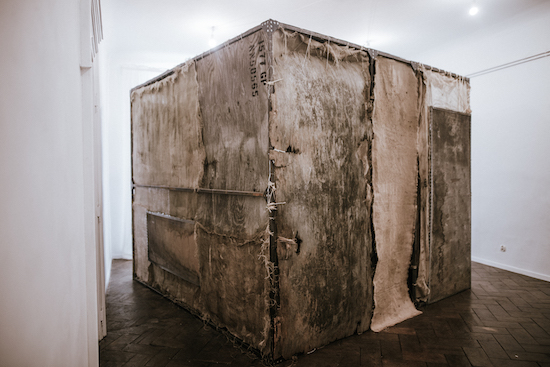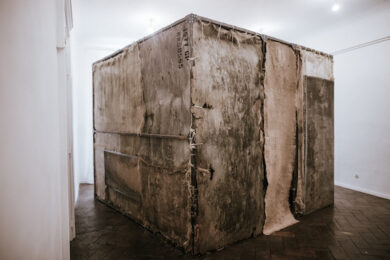Krzysztof Gil, TAJSA Yesterday and Tomorrow, 2018. Installation detail, Henryk Gallery, Kraków, Poland. Courtesy Henryk Galery and l’etrangere
In a climate where the far-right are stirring up Roma hatred Krzysztof Gil has chosen a far-back history of this persecution as the subject of his installation and drawings, brought to London with the support of the Polish Cultural Institute and the Municipality of Kraków.
On Charlotte Road, Shoreditch, a street proudly bannered with claims for ‘low car emissions’, a small gallery has in its window what looks like a tent made of animal skins, hessian, brown earthly cloth. Yet it invites me in as an accidental gallery visitor with an hour to kill before my graphic novel class at the Royal Drawing School.
It’s the private view night and I’m here just before it kicks off. So I wander round the two rooms. First I go to the back and explore the drawings, the beautiful rendered chalk greyhounds, the hunting dogs, the faces of historical gentlemen in ruffs and blouson sixteenth-century clothes. I avoid the main structure that I saw through the window as this is clearly the central piece where something conceptual as well as illustrative is being worked out. These drawings are overspill of the central installation, made of natural materials hung from a steel box frame.
I lift up the canvas and skin doorway of the deep brown black shelter and go inside the nomadic construction. It’s round inside, unlike the square exterior. I turn around. Underneath my feet the floor is peat-like, soil-like. There’s an organic – not unpleasant – but musty smell. It has a familiar texture to my nose. It’s dark here. A spotlight circles, shedding a bright light on the round wall. This is a ritualistic space and I must wait for the narrative to evolve. There is no film playing but I am immersed in a spectacle reminiscent of a nineteenth-century panorama.
Before my face an object swings, like a bone wrapped with hair, an organic shape. And as the light moves I start to see the faces gathered around me. I am in the centre. The focus of their eyes, of their emotion. I am trapped here. Around me the chalky greyhounds, the hunting dogs are gathered at the feet of their masters, and this does feel an exclusively male panorama. I’m here, witnessing the hunters, circled around me and they are witnessing me.
I would not say that this exhibition stirs up fear. Not now. It feels peaceful. I am not frightened of these figures. They are too beautiful, too deliberately elegant. The presentation is not from an aesthetic of fear but of one celebrating the life of the nobility. The artist has drawn on Velasquez and the browns of Rembrandt in particular one painting, The Anatomy Lesson of Dr Nicolaes Tulp (1632) in which Dr Tulp shows a public dissection to the members of the Amsterdam Guild of Surgeons. I read this later on the handout. For now I watch as the dogs’ faces emerge out of the dark and it becomes gradually clearer what is on display here. I understand there are human figures among the kill but it’s hard to make them out. That’s part of the mystery and the journey of the viewer, to struggle to see the victims.
Krzysztof Gil joins me to explain his installation, TAJSA Yesterday and Tomorrow (2018). It takes as its point of departure the ritual of ‘Heidenjachten’ or ‘Gypsy hunt’ which was prevalent in Germany and the Netherlands from the seventeenth to as late as the nineteenth centuries. It echoes the situation during the twentieth century, made conscious through his choice of audio. While standing in the tent we hear his grandmother’s voice telling her memories. His family originate from the Burgetka Roma community who settled in Podhale in the fifteenth century. In the second world war and after, the persecution continued. She remembers her father, who was murdered for calling into question the quality of work of his Polish colleagues. The authorities concluded that his death was accidental.
My own family, I have been told, come from what is now Kaliningrad, where German ‘wolf-children’ lived parentless, scavenging from bins when it became a Russian exclave after the end of the second world war. There is talk that our family originally left because of anti-Jewish pogroms, but by the time I was born that cultural influence had disappeared, at least consciously, leaving only a sense of Scottish cultural heritage. I have never followed our family history but the possible story gives me a sense of identification which seems to me to helps my emotional understanding of the histories of the hunted.
The swinging switch, the shamanic object hanging in the centre of the tent is based on a Roma artefact, an item used for its power to beat back evil. Like the Pendle witches and other persecuted minorities, bone, hair the mystery of spells, that is what is here to fight the dark, and the sense of comfort that magic articles give. The feeling of power that they seem to convey, although they are not conventional weapons or defensive materials, is reassuring to victims who have nothing else to rely upon. I’m reminded of the shamanic installations of London artist and potter Mandee Gage who wraps hair and rope round pottery and bone in warning pieces, expressing her fear of impending ecological disaster.
Kryzystof explains that the smell that I have been so aware of, that smells so familiar and so distinctive is from a Roma tradition of burning cloth to cleanse a home. It is musky and warm, thick and strong. For me it is an important sensual part of this experience. Together we cast our eyes about the home that is not a home. It is a panorama of oppression, painted beautifully. He tells me that he has been very keen not to present too much narration in the picture. He did not want it to be like a nineteenth-century history painting. He did not want tell too much, like a film or comic strip. He wants the story to emerge gradually out of the darkness. Details emerge one by one. We begin to see the carcasses, the human child, the dead Roma among the trophies.
As he talks I begin to see the violent truths hidden at the bottom of the picture and think more deeply about the history which Gil is presenting. How Roma peoples lived in fear of punishment, enslavement and death. I read in the accompanying literature how in the sixteenth century the Holy Roman Emperor, Maximilian 1 passed anti-Roma laws making it legal to torture and exterminate Roma people. In 1530 the Roma were legally banished from England and in 1540 from Scotland. Then in the seventeenth century legislations came into force in Germanic states and the Netherlands determining that Roma individuals could be killed without liability. These hunts became official, organised by the police and the army together. They were public entertainment with cash prizes awarded to successful hunters.
I feel I need to research more, and think of the work that my friend the journalist Susan Schulman has done in relation to the marginalisation of Roma in recent years, reporting from Czenyete in Hungary where the only work available to Roma is ‘public works’ jobs such as cleaning streets on minimal ‘subsidies’ payments. Families report surviving by rummaging through garbage bags to find food and cosmetics. The families report that many do not say hello even when they pass by, not even to the children. People from other backgrounds walk by on different sides of the street. Roma children confess that they do not want to go to school as the teachers do not defend them from bullying or violence. Now I’m scared.
Research, read, think and then go to this chilling installation, this brown hut where quarry cannot be protected by amulets, scents or their canvas bone and steel dwelling, stand inside and identify with the hunted. You will find an experience to rival any contemporary CGI action movie; so still but very, very moving.
Krzysztof Gil, Welcome to the Country where the Gypsy Has Been Hunted, is at l’étrangere , London, until 5 January 2019



